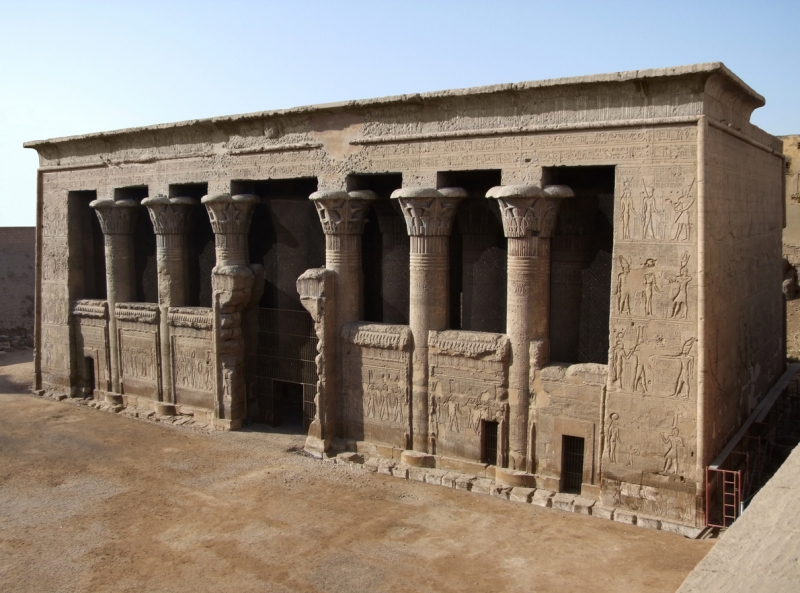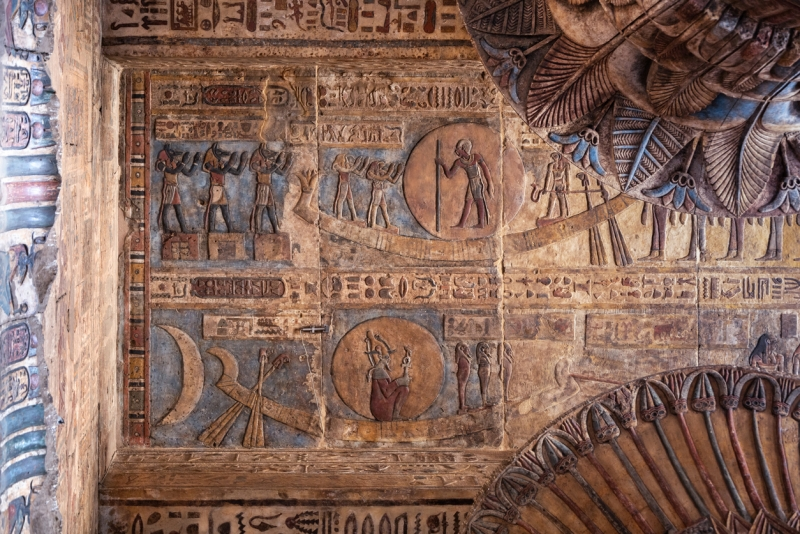Temple of Esna

- When was the Temple of Esna built?
- The importance of rituals in ancient Esna temples
- The modern town Of Esna
The city of Esna is home to a few of the most famous ancient Egyptian temples. Esna was one of the most prestigious cities in Ancient Egyptian civilization, during the Roman and Ptolemaic periods their influence can be strongly noted in the temples around in this area including the Temple of Esna, also known as Temple of Khnum.
Where is the Temple of Esna located?

When was the Temple of Esna built?
The remains of the Temple of Esna contains a hall of columns with 24 pillars beautifully decorated with lotus floral capitals and palm capitals. The walls are covered with 4 rows of reliefs, showing Ptolemaic and Roman Emperors dressed in Pharaoh costumes, offering sacrifices to the god Khnum. There are chambers on both sides of the temple entrance that were used by the priests and keepers of the temple as storerooms.
Flanking the entrance to each room, you will notice Emperor Trajan, carried in a litter by six Priests, with jackal and hawk masks of the gods. The most interesting inscriptions in this temple are the ones you will find on the roof, which is decorated with astronomical representations. On the left side of the gateway of the Temple, you can see the sky Goddess Nut, the Dog Star, Orion's belt, and Alpha Draconis (or the Dragon Star).
On the western wall of the façade of the Temple, you can see the God Horus, God of victory, and the God Khnum, dragging a net full of fish from the Nile, as well as reliefs of birds. Significantly at the foot of this representation is the last known hieroglyphic inscriptions ever recorded, completed by the Roman Emperor Dios in 250 A.D.

The Importance of Rituals in Ancient Esna Temples

Customize Your Dream Vacation!
Get in touch with our local experts for an unforgettable journey.
Plan Your TripThe Modern Town of Esna
Come and visit the Temple of Esna and more by taking one of our Nile Cruises.

Historical Significance of the Temple of Esna
The Temple of Esna holds great historical importance because it reflects three major eras of Egyptian history—the New Kingdom, the Ptolemaic period, and the Roman period.
- Initial construction began under King Tuthmosis III of the 18th Dynasty (c. 1479–1425 BC).
- The temple was expanded, decorated, and completed between 40 and 250 A.D. under Ptolemaic rulers and Roman emperors such as Claudius, Trajan, and Hadrian.
- It also preserves the last known hieroglyphic inscription ever carved in ancient Egypt (dated to A.D. 250), making it a key marker of the final chapter of pharaonic culture.
Visitor Information for the Temple of Esna
Opening Hours
- Daily: 7:00 AM – 7:00 PM
- (These hours may vary slightly by season or holidays.)
Ticket Prices
- Foreign Adult: Approx. 140–160 EGP
- Foreign Student: Approx. 70–80 EGP
- (Prices may change, so it’s good to check on arrival.)
How to Get There
- From Luxor: Esna is about 55 km south of Luxor (45–60 minutes by car).
- You can reach it by private car, taxi, or as part of a Nile cruise, which usually stops in Esna while the ship passes through the famous lock.
- From Aswan: Around 170 km north (2.5–3 hours by car).
Best Time to Visit
- Early morning or late afternoon for cooler temperatures and better lighting for photography.
What to Expect
- A partially buried temple hall surrounded by the modern town.
- Stunning restored ceilings with brilliant colors.
- 24 beautifully carved columns and rare astronomical inscriptions.
The Temple of Esna is located in the city of Esna, about 55 km south of Luxor in Upper Egypt. It sits near the Nile River in the center of the modern town.
The surviving part of the Temple of Esna is around 1,800–2,000 years old. Most of what we see today dates to the Roman period, mainly from the reigns of emperors like Claudius and Hadrian.
Construction began during the Ptolemaic period, but the temple was mostly built and decorated between the 1st and 3rd centuries AD under Roman rule. An older temple once stood on the same site, but only the later structure remains.
The Temple of Esna is famous for its beautifully preserved hypostyle hall, featuring 24 massive columns with intricate floral capitals. It’s also known for its vivid ceiling restoration, where original colors and zodiac-like imagery have recently been revealed.
The main deity of the Temple of Esna was Khnum, the ram-headed creator god believed to fashion humans on a potter’s wheel. The temple also honored his divine family: Neith, Heka, Satet, and Menhit.
Khnum was an ancient Egyptian creator god, depicted with the head of a ram. He was believed to form humans on a potter’s wheel from Nile clay and shape their bodies and destinies. Khnum was also the god of the Nile’s source, fertility, and rebirth, making him one of the oldest and most important deities in Upper Egypt.
The Temple of Esna is unique because of its exceptionally well-preserved hypostyle hall and its recently restored ceiling, which reveals vivid original colors and detailed astronomical scenes. Unlike many temples, only this hall survives today, allowing visitors to clearly see the Ptolemaic–Roman artistry, 24 massive carved columns, and inscriptions recording rare priestly rituals and festivals.








